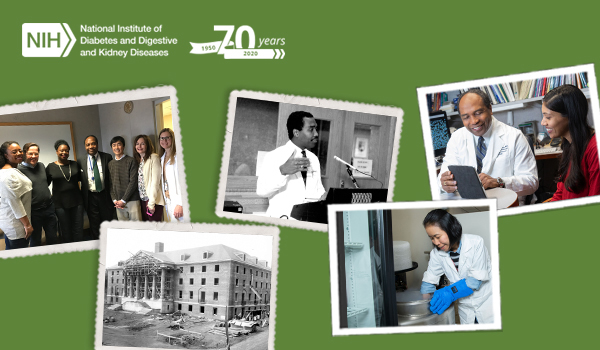Celebrating 70 Years: More Research Advancements

Additional highlights from NIDDK research that are shaping scientific advances of the future.
As we continue to honor NIDDK’s 70th anniversary, we look back at NIDDK-supported research from the last seven decades that have furthered our understanding of the prevention and treatment of chronic diseases. In our first 70th anniversary blog post, we highlighted some of our research advancements in diabetes and kidney disease. In this second post, learn about some of our scientific discoveries in nutrition, obesity, liver disease, digestive diseases, and sickle cell disease. Visit our 70th anniversary page for more information about our past, present, and future focuses in these areas.
Nutrition – Clinical Studies of Diet and Nutrition
An NIDDK controlled feeding study found that people consumed more calories per day and gained weight on a diet of ultra-processed foods, whereas they lost weight on an unprocessed food diet. Studies such as this, where participants are provided with all their meals and snacks, avoid the pitfalls of self-reported dietary assessment tools.
In another study, NIDDK-funded researchers showed benefits of time-restricted feeding in individuals with metabolic syndrome. Participants consumed their usual daily diet within 10 hours and experienced moderate weight loss, and, in some cases, lower blood pressure, lower blood glucose levels, and other improved outcomes.
Obesity – Surgical Interventions as a Treatment Strategy
The NIDDK-supported Teen-LABS (Longitudinal Assessment of Bariatric Surgery) is an observational study assessing the short- and long-term risks and benefits of bariatric surgery in teens who have severe obesity and serious weight-related health problems. Researchers found major improvements in weight, heart health, prediabetes, type 2 diabetes, blood pressure, cholesterol, and kidney function 3 years after surgery. Moreover, 5 years after weight-loss surgery, researchers compared the results for teens in the study to results for adults who had the same procedure. While weight loss was substantial and similar between the two groups, teens with type 2 diabetes before surgery were more likely than adults to have their diabetes resolve after surgery without diabetes medications. Teens were also more likely than adults to no longer have high blood pressure after surgery or take blood pressure medications.
Inflammatory Bowel Disease (IBD) – The Genetics of IBD
The NIDDK’s IBD Genetics Consortium (IBDGC) is identifying genetic variants that are associated with IBD. In collaboration with the International IBD Genetics Consortium, of which it is a member, the IBDGC has enrolled thousands of IBD patients and identified more than 250 regions of the human genome that convey risk for the disease. This work established genetics as a key driver of IBD and is continuing to yield important new insights into the complex and individual nature of the disease.
Chronic Liver Disease – Viral Hepatitis
For chronic hepatitis B, both interferon and direct-acting antiviral (DAA) drugs have been shown to be highly effective in suppressing viral infection and treating liver disease. But these drugs must be taken long-term if not indefinitely, and only cure the disease in a proportion of individuals. Studies by the NIDDK’s Hepatitis B Research Network show that careful management of patients with chronic hepatitis B leads to long-term survival and low rates of cirrhosis, liver cancer, and end-stage liver disease with only rare adverse effects. Better regimens of DAAs and interferon promise to further improve outcomes.
Sickle Cell Disease – Developing Treatment Strategies
Based, in part, on NIDDK-supported research, hydroxyurea became the first agent approved by the U.S. Food and Drug Administration for preventing painful sickle cell episodes in patients 2 years of age and older. Hydroxyurea increases life expectancy, reduces emergency department visits and hospitalizations, and is cost effective for gravely ill adult patients. Hydroxyurea works by increasing the concentration of fetal hemoglobin (the predominant form of hemoglobin at birth that typically drops to very low levels by 6 months of age) in the red blood cells of patients with SCD, thus diluting the concentration of sickled red cells. The drug is the only one approved by the FDA for treating SCD, and in many patients it reduces common complications such as severe pain, organ damage, and ameliorates anemia.
